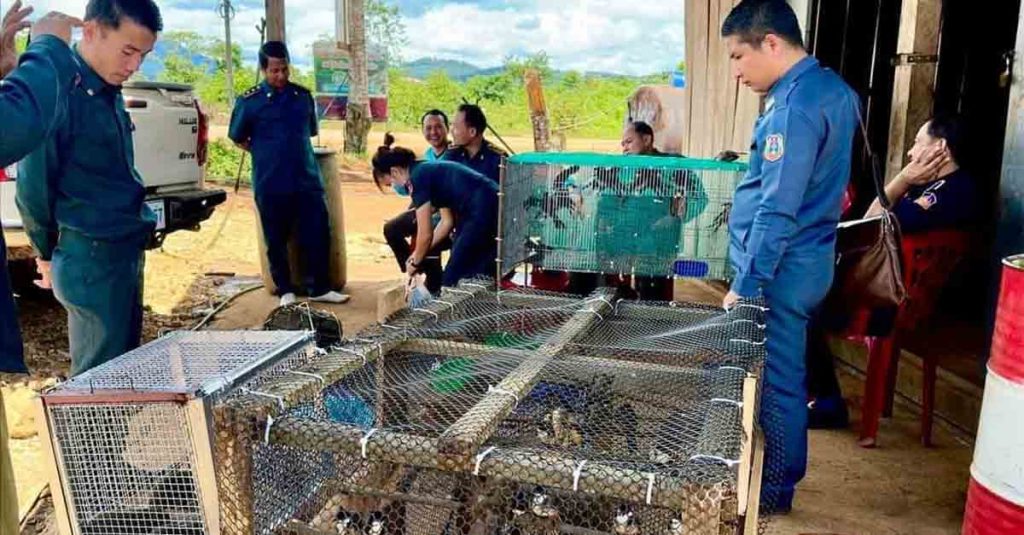Wildlife hunting remains a significant challenge in Laos, despite ongoing efforts by the Lao government and non-governmental organizations (NGOs).
According to a wildlife expert, who goes by the pseudonym “Ben” to protect his identity due to his involvement in national policy making, a significant factor driving illegal hunting is the demand for exotic dishes featuring wildlife. Ben noted that this demand primarily stems from tourists from neighboring Vietnam and China.
Tourism-driven Demand Fuels Illegal Hunting
The expert highlighted the role of organized tour groups in promoting the consumption of wildlife meat among tourists. These tour groups offer luxury banquets featuring exotic products, including pangolin and bear paws, contributing to the perpetuation of illegal hunting practices, underscoring the need for targeted interventions to address this concerning trend.
Numerous restaurants across Laos, often with ties to poachers and middlemen, capitalize on tourists’ quest for unique culinary experiences by offering dishes made from wildlife. This practice not only sustains but also exacerbates the demand for wildlife products, perpetuating illegal hunting in the country.
Despite this being a widespread issue, Laos has established laws aimed at combating these activities. According to the Penal Code, initial offenders responsible for minimal damage can undergo “re-education” rather than facing immediate penalties. However, assessing the value of the animal in question presents a significant challenge, often relying on fluctuating market prices.
For repeat offenders or individuals engaged in organized hunting endeavors, stricter repercussions are enforced. These penalties may include fines of up to LAK 10 million (equivalent to approximately USD 472.22) and imprisonment for a maximum duration of five years.
Enforcement Challenges in Rural Areas

Enforcement of wildlife protection laws, however, poses significant challenges, particularly in rural areas where illegal hunting has long been a cultural norm.
“In rural areas, hunting has never been seen as a crime,” Ben said. He also highlighted the difficulties faced by authorities in enforcing laws against individuals who hunt for food or to sustain their livelihoods.
Limited resources and the inability of offenders to pay fines further complicate enforcement efforts, creating a complex landscape for conservationists and law enforcement agencies alike.
Uncertainty Surrounding Conservation Rules
The Wildlife Conservation Society, a United-States nonprofit organization with conservation programs in Laos, highlighted the strict prohibition against hunting protected species in Laos. However, the uncertainty surrounding hunting seasons and areas complicates efforts to educate the public, ultimately resulting in the unintended hunting of animals meant for conservation.
Central to the challenge of wildlife conservation in Laos is the classification of animals into three distinct groups: protected species, managed species, and those that can be hunted in community areas.
Protected species, including majestic animals like elephants, tigers, and bears, are strictly off-limits for hunting. Managed species, such as pigs and deer, are subject to regulation, allowing for their controlled harvest by rural villages for subsistence purposes. However, the complexity arises from the lack of clarity regarding the specific seasons and areas where hunting is permitted, leading to inadvertent violations of conservation rules.
International Cooperation and Online Trade
The rise of online wildlife trade also presents an additional challenge for authorities, as it allows for the anonymous sale of protected species on social media platforms.
“Every day, protected species like pangolins, bear cubs, cats, monkeys, and turtles are being sold on Facebook,” Ben observed, pointing to the need for enhanced monitoring and enforcement measures to curb this illicit trade.
International organizations, such as the ASEAN Wildlife Enforcement Network, have also joined the fight against the illegal wildlife trade in Laos. While some progress has been made, major wildlife traffickers, known as kingpins, remain elusive.
“Members of the networks have been arrested in Thailand and Vietnam, but none of the kingpins or the major wildlife terminals have ever been arrested in Laos,” the expert revealed, highlighting the need for greater international cooperation to apprehend these elusive criminals.
Furthermore, Laos serves as a convenient gateway for trafficking wildlife from Africa to consumer markets in countries like Vietnam and China. While these products are not used in Laos, the country’s geographical location makes it vulnerable to smuggling activities. This international dimension adds complexity to conservation efforts, as it requires strong international cooperation to combat wildlife trafficking effectively.
Ben further noted the difficulties of enforcing wildlife protection laws in Laos, citing the country’s extensive porous borders and the high demand for wildlife products in neighboring nations. Notably, Laos shares its borders with five countries, two of which are significant consumers of wildlife products. This geographical proximity poses challenges in regulating trade. Ben highlighted the necessity of international cooperation to effectively investigate smuggling networks that span across borders and involve individuals residing in other countries.
Local Efforts to Combat Threats to Wildlife

The expert emphasized the importance of community involvement alongside enforcement and education efforts. He suggested that empowering local communities to responsibly manage and derive benefits from wildlife resources could play a pivotal role in mitigating illegal hunting and trade.
Despite ongoing challenges, authorities are actively engaged in efforts to combat threats to wildlife, as demonstrated by the recent rescue of 16 bear cubs by Free the Bear in the Sikhottabong district of Vientiane Capital on 17 March. Although the origins of these bears remain unknown, reports indicate that they are currently receiving medical care at a center in Luang Prabang and are slated for eventual release into the wild.



